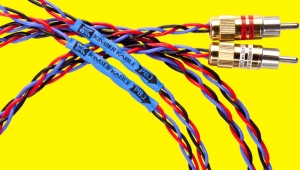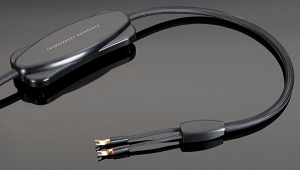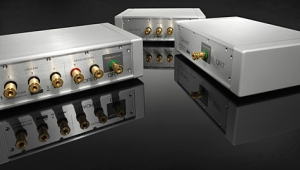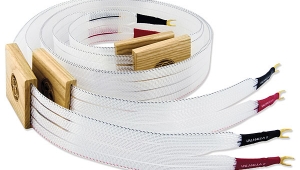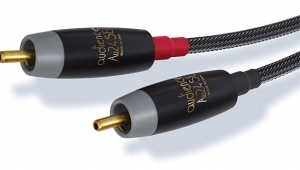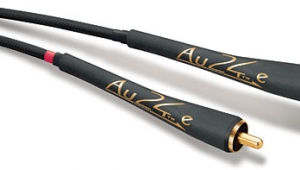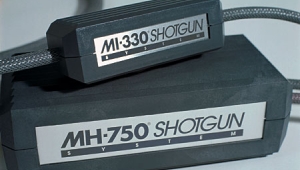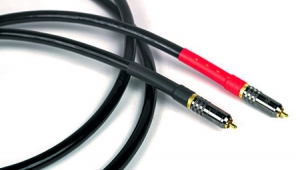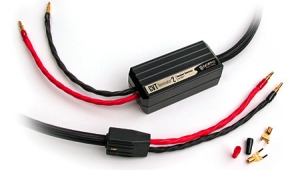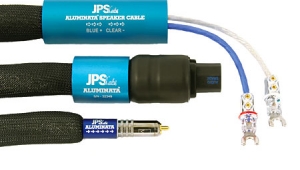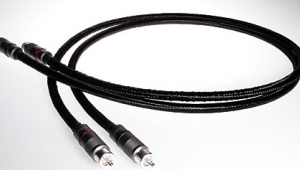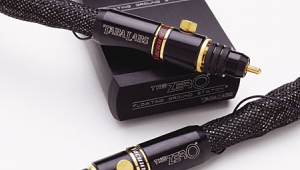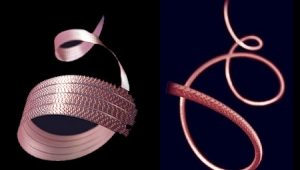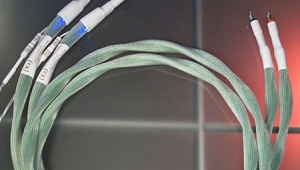| Columns Retired Columns & Blogs |
AudioQuest Cheetah interconnects & Mont Blanc speaker cables Manufacturer's Comment
Manufacturer's Comment
Editor: Like any greedy manufacturer (cable guys aren't actually a different class), I appreciate it when my products get attention, and I appreciate it more when they get compliments. So I should just write like a normal manufacturer, thanking Art Dudley for his time and attention and for the good review, and maybe sucking up just a bit about how intelligent and enlightened he was to have described so well the subtleties of my products—or I can be good old, barely tolerable, contrarian me, and focus on the deficiencies instead of the positives.
I can only agree with what Art heard and the way he described it. Around the world, from press, dealers, and consumers, the most common comments AQ receives are about a black and quieter background—"a darker, deeper silence," as Art described it.
My complaints are about far more fundamental issues of objectivity and the intrusion of cynicism. I read Art's cable review with a brand new combination of shock, horror, and appreciation. I've read reviews I wasn't comfortable with before. However, the demonstrated superior sensitivity and professional style that Art brings to the game, combined with healthy skepticism, very unhealthy cynicism, and a notable lack of what I term "evaluation methodology," make Art's review something new in the way of love/hate.
Our industry, whatever it's called these days, has always had and will always include manufacturers of every type of product who either obscure the truth or make up their own truth. Cable manufacturers are not such a different breed. It's an old story that, because cable appears simple and doesn't do anything, those who don't understand it take insult at their own ignorance. It's so much easier to accept not understanding everything about digital processors.
The mindset is that electronics and speakers do something; therefore, how well they do it is considered as a degree of active-positive. All that a cable can do is try to do nothing. It's not really the fault of cable companies that the language of our industry is always about positive actions, and therefore most sales BS from all manufacturers is about positive actions—though even in the active components, it's the passive damage caused by individual parts that accounts for much of what we hear.
This extreme bias toward considering all differences "active" causes even some of the industry's most respected reviewers to describe differences in cable performance as being the result of amplitude variation. Talk about BS—even (most of) the cable guys themselves don't say such crap. I'm delighted that Art wasn't seduced by this all too prevalent variation of reviewer incompetence. Energy hitting the auditory system is not the same thing as the brain (CPU) presenting the information content of this energy to the consciousness—and therein lies most of the misunderstanding in the hi-fi world.
Does our Dielectric-Bias System (DBS) work? I consider it entirely appropriate and laudable that Art is skeptical—but I sure wish he had talked to someone at AudioQuest, especially me, about his not adequately informed views of dielectric. Not because he should swallow anything I say, but he would have had something to verify, instead of more or less relying on existing prejudices. My own language describing dielectric and DBS has evolved considerably since my first writings about dielectric, from which Art quotes some bits.
Anything next to a conductor is a dielectric. (I don't make this stuff up!) The only perfect dielectric is a vacuum. For our audio purposes, air is practically perfect compared to any solid material. Most commonly, dielectric is described by the specification dielectric constant, a characteristic causing loss. Loss is a big problem in the high-frequency world, in which cables also have specifications such as propagation delay. In the audio world, loss due to dielectric material is usually insignificant, but the phenomenon that causes propagation delay is a big deal.
Any nonperfect dielectric—anything other than a vacuum—causes something akin to resistance to the magnetic field that accompanies any current flow. I want to be very careful about the "akin to" part—I'm only trying to make a semi-understandable analogy. However, "akin to resistance" applies in two ways, because of both loss (not relevant here) and resistance, as when dropping a coin into a bottle of shampoo. Dielectric slows down the magnetic field traveling through it, and therefore slows down the current traveling in the conductor.
If it took music a minute to come out the other end of a cable, it would be like using an early SACD player: inconvenient for the first minute, but otherwise irrelevant. Unfortunately for us, the degree of "resistance," the amount of time delay, known as phase shift, is different for every frequency and different for every amplitude. These nonlinear phase errors are why manufacturers justifiably worry about capacitor materials, circuit-board materials—and cable insulation. Although cable is not intended to store energy and stores very little energy, it still suffers these same problems. The technical specifications permittivity and permeability describe these dielectric parameters.
I appreciate Art's quoting my displeasure with the common North American idiosyncrasy of using the term break-in when referring to how electronics, loudspeaker crossovers, and cables change in performance during their first weeks of use. Occasionally, thermal stability makes a difference; otherwise, these changes are almost entirely symptoms of dielectrics becoming at least partially polarized. I prefer the not quite accurate term warmup to describe this adjustment process, because at least warmup includes the concept of cooldown—that the product can go back to its "cold" (new) state.
The other common term is run-in—not as bad as break-in, but still implying something not true. While playing music or otherwise running signal through a system does warm up the equipment, it is not the running of current that facilitates the improvement. It is the not-coincidental field associated with the current that, at least partially, electrostatically aligns the molecules of the dielectric. This field doesn't need to be modulated. Current does not need to travel. A static, nonchanging field is actually preferable.
A field exists. A field does not represent "work." When Art theorizes that DBS can't really be doing anything because there is no current draw on the batteries, he fails to consider potential and field. The amount of energy stored and the need for it to then be dissipated have nothing to do with the core phenomenon of polarizing a dielectric.
Using an analogy again, the Earth's magnetic field causes a compass to point relative to that field. In school science classes, many of us once used a magnet and iron filings in order to learn that the filings would point toward (and eventually be drawn to) a magnet. When the filings point toward the magnet, they are being aligned relative to a field. Many of you who remember the joys and pains of LPs recall the significant improvement in performance made possible by "demagnetizing" a phono cartridge. Well, that's more improper language. A phono cartridge with a magnet as a crucial part of its "motor" can't be demagnetized—the improvement comes from re-orienting or re-aligning the magnetically sensitive materials within the cartridge.
DBS provides a cable with a fixed, stable electrostatic field that orients or aligns (the technical term is electrostatically polarizes) the molecules of the dielectric—of the insulation. This is important because a polarized dielectric causes more nearly uniform phase shift instead of the nonlinear variety of different degrees of phase shift caused by an unpolarized dielectric. I don't make this stuff up. I didn't need help hearing the problem or the benefits of a solution, but I did need help with the technical terminology. My coach is a senior proofreader of TRW's technical papers.
The real question is, does this matter? Can it be heard? The method for evaluation is extremely simple, something many AudioQuest dealers are now demonstrating for their customers. Simply compare two pairs of the same cable, with and without DBS. This is such a simple comparison that most dealers attach both sets of cable to the same source (often with a solid no-wire $wY-adapter), then connect the cables to two inputs on the same preamp, and simply switch inputs. Normally, I am very much against any sort of instant switching—it is more often used to sell bad equipment than to gain understanding—but in this case just a few seconds usually ends all doubt. Two AudioQuest models are the same cable with and without DBS, so dealers often compare King Cobra (no DBS) with Jaguar (with DBS). I would love to have supplied Art with a second pair of Cheetahs so he could have made the same comparison.
Art quotes comments I made early on about the appropriate voltage for the DBS system—embarrassing comments, because I now understand how wrong they are. Yes, I also can get suckered by an already existing attractive argument, and fail to properly test with an open mind. I fell for the logic that having a bias voltage higher than the signal voltage meant that the job was done. With hindsight, this was sort of a "bits are bits" load of idiocy. If you followed the magnetic analogy above, then you can appreciate that the answer to the question of how high a voltage is needed is "as high as is required by the material;';'—nothing to do with the signal voltage; it's a material need. The exception is AC power cable. As long as AC cable is kept plugged in (not turned off by an upstream switch), then the 115V or 230V AC potential makes DBS completely irrelevant. The equipment does not need to be turned on, though of course all solid-state equipment should be kept turned on (warmed up) for maximum performance.
I appreciate how much fun Art has making fun of "Bad, willful electrons!" Unfortunately, he didn't understand that when a shield is connected at only one end, it cannot be considered a parallel conductor, much less an equal parallel conductor. He starts with the fairly normal prejudice that the ground of a balanced connection is static and therefore its conducting qualities are irrelevant. I don't fully understand (though I would like to) why this normal view is clearly too limited, too low-altitude. All I need to know, and to act on, is that the quality of the wire that is connected to pin 1, and the quality of metal and plating used in pin 1, make a blatant and unignorable difference. (I had hoped I could use a cheaper material on pin 1. I couldn't.) So whether or not the quality of material used for the pin 1 connection makes a difference is, until Art has appropriate cables and connectors to listen to, just a theory for him. But the thing about how "willful electrons" might equally well have traveled on the conductor (shield), which is connected at only one end, is simply night-and-day wrong.
Art's discussion of AudioQuest's use of conductive insulation in many of our speaker cables did not include either a reasonable technical investigation or a subjective/empirical investigation. Instead of any attempt to understand or test the effect, it is labeled "nonsense."
There's a wonderful irony in such blindness. After years of my asking all the technical-type friends I have in the industry to help me understand both why TARA Labs' TFA Return made an important difference (important only on the negative connection), and why the same perceived difference could be had by using conductive insulation (important only on the negative), I finally got an answer when key Belden Cable engineer Steve Lampen—he of comparative Internet fame as a conservative cable semi-naysayer—was in my office. Steve was the first who could see that the 8 ohm pot on TARA's Temporal Continuum speaker cable (in-line with the TFA Return) was functionally a tuner and not a variable resistor, and who understood the high-frequency damping ability of conductive dielectric. I use the word see above because Steve didn't figure anything out; he simply knew enough basics, wasn't blinded by a preformed opinion, and saw the truth.
The easiest way for anyone with one of the AudioQuest cables that use conductive insulation (pretty funny term, isn't it!) to test whether there is an effect is to simply reverse the red and black connections on both ends of the cable. The comparative loss of three-dimensional space, the introduction of more grain and irritation, will be the difference between the significant benefit of using conductive insulation on the negative connection vs the minor benefit from using this material on the positive. Currently, the Flat Rock cables (Slate, Bedrock, Gibraltar) and the Earth Feature cables (Pike's Peak, Mont Blanc, Volcano, Kilimanjaro, Everest) use conductive insulation.
Well, that's more than enough obnoxiousness from me in one sitting. I can't stress strongly enough how I wish there was more opened-minded scientific investigation in our world. Art is one of the most sensitive and sophisticated listeners, journalists, and investigators in our world, and yet he, same as me when I was blind to proper voltage investigation, has a long way to go.—Bill Low, CEO-Designer, AudioQuest
- Log in or register to post comments
